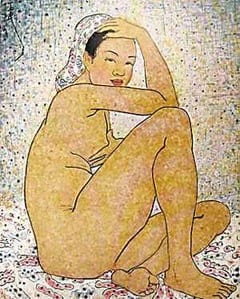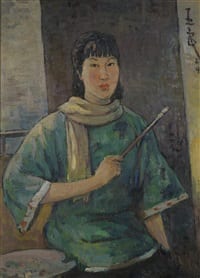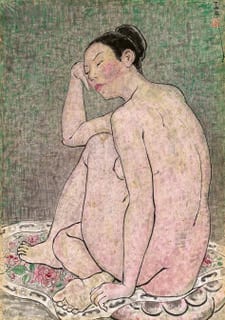Naked and Strong: the Chinese Painter Obsessed with Nudes
The women in Pan Yuliang’s nude paintings are shown in quiet abandon under the painter’s gaze, yet from their nudity comes not vulnerability but strength. Depicting her sitters as endowed with subjectivity is a bold artistic move given that, in art, women are more often passive muses than agents of artistic creation.
 Born in 1895 in Jiangsu Province, East China, Pan Yuliang was orphaned and sold as a maid into a brothel at the age of 14. Her freedom was later bought by customs officer Pan Zanhua who made her his concubine and introduced her to the intellectual and artistic circles of Shangai. She learned to paint from a neighbour and in 1918 she was the first woman to be admitted to the Shangai Art Academy. She later went to Paris and Rome to complete her art training.
Born in 1895 in Jiangsu Province, East China, Pan Yuliang was orphaned and sold as a maid into a brothel at the age of 14. Her freedom was later bought by customs officer Pan Zanhua who made her his concubine and introduced her to the intellectual and artistic circles of Shangai. She learned to paint from a neighbour and in 1918 she was the first woman to be admitted to the Shangai Art Academy. She later went to Paris and Rome to complete her art training.
While in Europe, Pan Yuliang became familiar with the works of French painters such as Manet, Cézanne or Matisse whose styles deeply influenced hers. She quickly mastered Western techniques of paintings but associated them with Chinese traditional brush and ink methods. In her artistic practice, she endeavoured to reconcile the two pictural traditions, and the way she uses oil paint and colours, but also bold contours, is exemplary of this blend. This well-balanced mix characterizes Pan Yuliang’s approach and has made her famous as one of the first Chinese artists to paint in Western style.

Pan Yuliang came back to China in 1926 and began a career as an art teacher at the Shangai Art School, where she would later head the department of Western Painting. Her paintings were acclaimed and exhibited but her depiction of the female body attracted criticisms. Her work was under increasing scrutiny, and in 1937 she left a China torn by war to avoid censorship and moved back to France.
Obsessed by the female figure, Pan Yuliang had a sometimes unconventional approach to painting. For lack of models, she would go in public baths for inspirations or use herself as a sitter. Her fascination for the female nude can be explained by the metaphoric potential she saw in the naked figure. A nude female body could mean both rebellion and submission, lust and motherhood, strength and vulnerability… The polysemy of this signifier had an obvious appeal to a painter torn between cultures, and she represented it profusely. Out of the 4 000 paintings and drawings she left after her death, about half are nudes of non-white women. The bodies she depicts are not exoticised, rather they display a quiet confidence under the well-meaning gaze of the painter. Showing ownership of their bodies, the sitters challenge the dominant association of beauty with whiteness, and of nudity with objectification.
 Pan Yuliang spent the remaining 40 years of her life in Paris. She taught at the school of Beaux-Arts and kept working on her own paintings. She was part of the Chinese expatriate community in Paris but was desperately homesick. She died in 1977 without seeing China again. Despite being remembered for introducing Western painting to China, it is truly in her depiction of the nude sitters as subjects rather than mere objects of the male gaze that she was avant-garde
Pan Yuliang spent the remaining 40 years of her life in Paris. She taught at the school of Beaux-Arts and kept working on her own paintings. She was part of the Chinese expatriate community in Paris but was desperately homesick. She died in 1977 without seeing China again. Despite being remembered for introducing Western painting to China, it is truly in her depiction of the nude sitters as subjects rather than mere objects of the male gaze that she was avant-garde
Sources :
Frieze : https://frieze.com/article/republican-era-shanghai-postwar-paris-pan-yuliangs-bold-portraits
Chronology : http://cdn.aaa.org.hk/_source/digital_collection/fedora_extracted/45815.pdf
Widewalls : https://www.widewalls.ch/artist/pan-yuliang/
Aware : https://awarewomenartists.com/en/artiste/pan-yuliang/
Lignan Art : https://www.lingnanart.com/2013_ChineseMaster/PanYuLiang/Master_panyuliang.htm
Artnet : http://www.artnet.com/artists/pan-yuliang/5
Ran Dian : http://www.randian-online.com/np_review/why-pan-yuliang/
Villa Vassilieff : http://www.villavassilieff.net/IMG/pdf/cp_eng_panyuliang.pdf
China Daily : http://www.chinadaily.com.cn/photo/2006-11/14/content_732470.htm